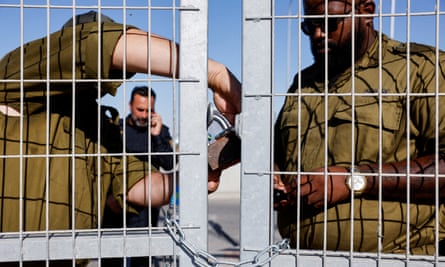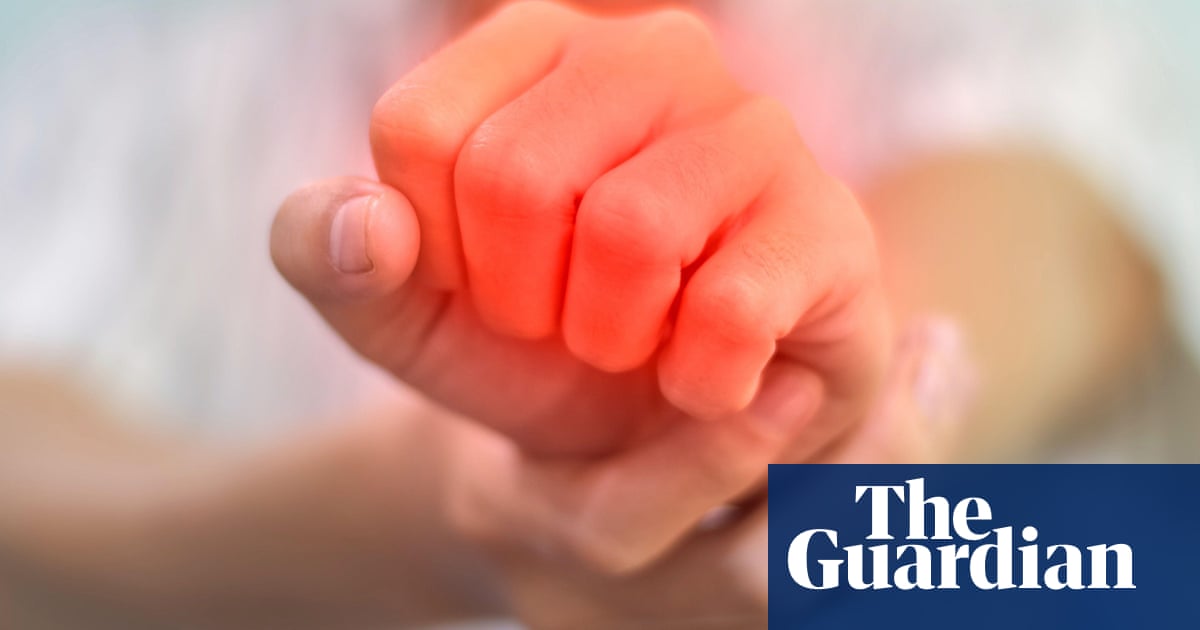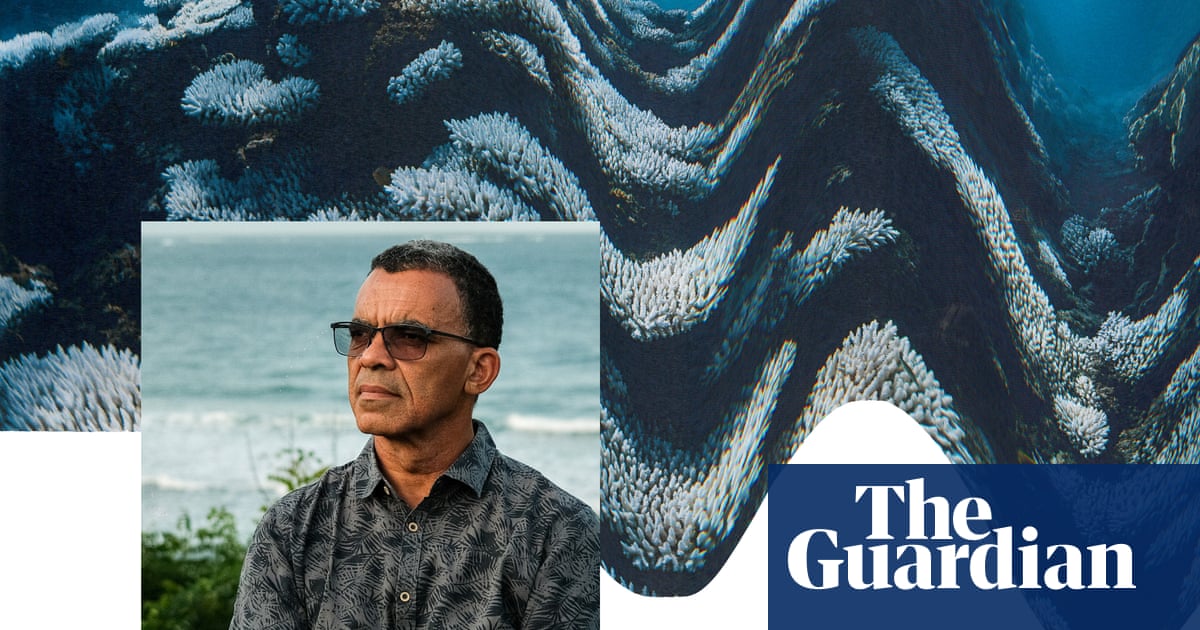At least 135 mutilated bodies of Palestinians returned by Israel to Gaza had been held in a notorious detention centre already facing allegations of torture and unlawful deaths in custody, officials from Gaza’s health ministry have told the Guardian.
The director general of the health ministry, Dr Munir al-Bursh, and a spokesperson for Nasser hospital in Khan Younis, where the bodies are being examined, said a document found inside each body bag indicated the bodies all came from Sde Teiman, a military base in the Negev desert where, according to photos and testimonies published by the Guardian last year, Palestinian detainees were held in cages, blindfolded and handcuffed, shackled to hospital beds and forced to wear nappies.
“The document tags inside the body bags are written in Hebrew and clearly indicate that the remains were held at Sde Teiman,” Bursh said. “The tags also showed that DNA tests had been carried out on some of them there.”
Last year the Israeli army launched a criminal investigation, which is continuing, into the deaths of 36 prisoners detained at Sde Teiman.
As part of the US-brokered truce in Gaza, Hamas has handed over the bodies of some of the hostages who died during the course of the war, and Israel has so far transferred the bodies of 150 Palestinians killed after the 7 October 2023 attack.
Some of the photographs of Palestinian bodies seen by the Guardian – which cannot be published due to their graphic nature – show several of the victims blindfolded, their hands tied behind their backs. One image shows a rope fastened around a man’s neck.
Doctors in Khan Younis said official examinations and field observations “clearly indicate that Israel carried out acts of murder, summary executions and systematic torture against many of the Palestinians”. Health officials said the documented findings included “clear signs of direct gunfire at point-blank range and bodies crushed beneath Israeli tank tracks”.
Eyad Barhoum, the administrative director of Nasser medical complex, said the bodies carried “no names but just codes” and that part of the identification process had started.
While there is substantial evidence that many of the returned Palestinians had been executed, it is much harder to determine where the victims were killed. Sde Teiman is a storage facility for bodies taken from Gaza but it is also a prison camp that has become notorious for deaths in captivity. Human rights activists are demanding an investigation to find out whether any of the dead were killed there, and if so, how many.
The body of Mahmoud Ismail Shabat, 34, from northern Gaza, bore marks of hanging around his neck, his legs crushed by tank tracks, which suggests he was killed or injured in Gaza and that his body was later taken to Sde Teiman. His brother Rami, who identified the body of his sibling by the scar from a previous head surgery, said: “What hurt us the most was that his hands were tied, and his body was covered with clear signs of torture.”
“Where is the world?” said Shabat’s mother. “All our hostages returned tortured and broken.”

Some Palestinian doctors say the fact that many of the bodies were blindfolded and bound suggests they were tortured and then killed during their detention at Sde Teiman – where, according to Israeli media reports and testimony from prison guard whistleblowers, Israel is holding nearly 1,500 bodies of Palestinians from Gaza.
A whistleblower who spoke to the Guardian and who witnessed the conditions of detention at Sde Teiman said: “I did witness a patient from Gaza being brought with a gunshot wound to the left chest. He was also blindfolded and handcuffed, naked as he arrived to the emergency department. Another patient, with a right-leg gunshot wound also arrived to my hospital in similar conditions.”
Another whistleblower has previously described how patients, all from Gaza, were handcuffed to the beds. They had all been dressed in nappies and were blindfolded.
He was told that some patients had come from hospitals in Gaza. “These were patients who had been captured by the Israeli army while being treated in Gaza hospitals and brought here. They had limbs and infected wounds. They were moaning in pain.”
He claimed the military had no proof that detainees were all members of Hamas, with some inmates repeatedly asking why they were there.
In one case, he said, he learned that a detainee’s hand had been amputated “because the wrists had become gangrenous due to handcuffing wounds”.
Shadi Abu Seido, a Palestinian journalist from Gaza who works for Palestine Today, who was released after 20 months’ detention at Sde Teiman and in another Israeli prison, said he had been seized by Israeli forces at al-Shifa hospital on 18 March 2024.
“They stripped me completely naked for 10 hours in the cold,” he said in a video interview published on Instagram by the Turkish public broadcaster TRT. “I was then transferred to Sde Teiman and held there for 100 days, during which I remained handcuffed and blindfolded. Many died in detention, others lost their minds. Some had limbs amputated. They suffered sexual and physical abuse. They brought dogs that urinated on us. When I asked why I had been arrested, they answered: ‘We have killed all the journalists. They died once. But we brought you here and you will die hundreds of times.’”
Naji Abbas, the director of the prisoners and detainees department at Physicians for Human Rights Israel (PHR), said: “The signs of torture and abuse found on the bodies of Palestinians recently returned by Israel to Gaza are horrifying – yet, sadly, not surprising.
“These findings corroborate what Physicians for Human Rights Israel has exposed over the past two years about conditions inside Israeli detention facilities – particularly at the Sde Teiman camp – where Palestinians have been subjected to systematic torture and killings by soldiers and prison guards.”
PHR said: “The unprecedented number of Palestinians who have died in Israeli custody, together with verified evidence documented of deaths resulting from torture and medical neglect – and now the findings on the returned bodies – leave no doubt: an independent international investigation is urgently needed to hold those responsible in Israel accountable.”
The Guardian submitted photographs of the bodies to an Israeli doctor who also witnessed the treatment of prisoners at the field hospital in Sde Teiman.
On condition of anonymity, the physician said one of the pictures “shows the man had his hands tied likely with zip ties. There is a change in colour between the arms and the hands at the level of the zip ties, likely indicating ischemic changes due to excessive restraints.”
He added: “This might be someone who was either injured and captured (thus died under Israeli custody) or someone who died due to injuries inflicted after his capture.”
Dr Morris Tidball-Binz, a physician specialising in forensic science and a UN rapporteur, said: “A call should be made for independent and impartial forensic assistance to assist efforts to examine and identify the dead.”
Contacted regarding the allegations of torture, the Israel Defense Forces said they had asked the Israel Prison Service to investigate. The IPS did not respond to a request for comment.
As for the alleged abuses at Sde Teiman and the torture of prisoners, the IDF previously said it treated detainees “appropriately and carefully” and that “any allegation regarding misconduct by IDF soldiers is examined and dealt with accordingly. In appropriate cases, criminal investigations are opened by the military police.”
Asked about the claim Palestinian bodies had come from Sde Teiman, the IDF said they “are not commenting on this matter”.
At least 75 Palestinian detainees have died in Israeli jails since 7 October 2023, according to the UN.

.png) 4 hours ago
4
4 hours ago
4

















































